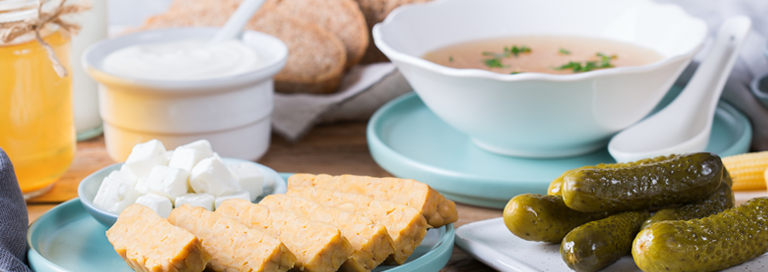Your hunter-gatherer ancestors enjoyed a kind of strength and immunity from disease that’s almost unheard of today.
Their secret was inside their gut.
Now, a landmark study from Harvard Medical School indicates your health isn’t dependent on your genetic inheritance after all. There are greater forces at work.
It supports my view that by nurturing a gut microbiome similar to your ancient ancestors, you can dramatically cut your risk of chronic disease.
Let me explain.
The “Mass Extinction” of Healthy Gut Bacteria
Harvard researchers suspected the real reason chronic disease is skyrocketing stems from a basic disruption in the bacterial balance of the human gut microbiome.
They compared the gut flora of three groups: 1) Those living in contemporary, industrial society; 2) contemporary hunter-gatherers who still consume a primal diet; and 3) hunter-gatherers who stalked the wilds of Utah and Mexico, hunting game 1,000 years ago.
Now, finding a way to analyze millennia-old gut flora might sound impossible. But, by re-hydrating the material in “paleofeces” – human waste well preserved in extremely arid regions – they were able to do it.
Among their remarkable findings:
- Their gut bacteria were dramatically healthier – far more diverse, more stable, and more resilient to stress and disease.
- Thirty-nine percent of the ancient gut bacteria they sequenced had never been seen anywhere before. They hypothesized these primal gut bacteria were completely wiped out by an “extinction event,” namely, the introduction of processed, chemical-laden, high-glycemic foods.
- Primal gut biomes had “markedly lower” levels of resistant bacteria. This reflects the impact of our mass use of antibiotics today.
- Ancient hunter-gatherers had far fewer bacteria that attack the mucus lining of the digestive tract. This causes “leaky gut syndrome” and rampant autoimmune disease.
- Finally, researchers report the gut microbiomes of ancient and modern hunter-gatherers are a lot alike, offering similar diversity and adaptability.1
This is just what I would expect after studying hunter-gatherers like the Hadza tribe in Tanzania.
Modern-day hunter-gatherers are remarkably strong and healthy. Diabetes, for example, is completely alien to them – they simply never experience it.
Now we know why. The gut flora of the Hadza tribe is similar to those of the primal hunters who lived a thousand years ago.
This means anyone consuming the right nutrients, protein, and fiber can be as strong and healthy as our primal ancestors were millennia ago. Let’s get started!
My 4-Step Plan to Primal Health
Here are four important steps to nurture a diverse gut microbiome:
- Put an end to “bacterial assassins.” You need to shield your beneficial gut bacteria from their mortal enemies. The antibacterial residues commonly found in food, for example, can devastate beneficial gut bacteria – one reason I strongly recommend eating grass-fed beef. Also, avoid artificial sweeteners like saccharin and sucralose as they tend to decrease healthy bacteria.
Other lurking threats include the chemical additives found in tap water, including chlorine. These will disrupt your natural gut-bacteria balance. To avoid them, invest in a good water filter.And be sure to avoid sugary carbs. They make pathogenic bacteria bloom, raising your risk of ulcerative colitis and leaky gut syndrome.
- Enjoy a wide range of fermented foods. These include: unsweetened Greek yogurt, kefir, kombucha, sauerkraut, sour cream, and natto, the Japanese dish of fermented soybeans.
They’re all excellent incubators for diverse, beneficial gut bacteria – the key to stopping inflammation in its tracks.
- Add new sources of fiber. The Hadza people love fruit from the baobab tree. It’s 50% fiber and packed with antioxidants.
The baobab fruit naturally dries out on the branch. So, the Hadza tribe use it as a flour or grind it into a powder they add to drinks or soup. It has a citrus flavor.You’ll find certified-organic baobab powders online. It should come from Africa, Australia, India, or Madagascar. But be sure to check the label to make sure there are no added sugars or preservatives.
- Pro- and Prebiotics. Given the importance of beneficial bacteria, supplementing with a good probiotic makes sense. Look for a probiotic with at least 10 billion colony-forming units (CFUs) daily with multiple strains of lactobacillus and bifidobacteria.
Also, look for a good prebiotic compound to help “fertilize” good bacteria. I recommend a special plant fiber called xylooligosaccharide (pronounced: zai-low-oli-go-sak-uh-rahyd), more commonly called XOS.Studies show two weeks of taking just three grams a day of XOS triggers a “dramatic shift” in microbiota,2 including a “significant increase” in beneficial bacteria and “significantly lower” disease-causing Clostridium perfringens,3 a bacterium that causes colitis.
To Your Good Health,
![]()
Al Sears, MD, CNS
References:
1. Wibowo, Marsha C., et al. “Reconstruction of Ancient Microbial Genomes from the Human Gut.” Nature, vol. 594, no. 7862, 1 June 2021, pp. 234–239. Accessed from Nature.com website, 6 July 2021.
2. Yang, J., Summanen, P. H., Henning, S. M., Hsu, M., Lam, H., Huang, J., … Li, Z. (2015). Xylooligosaccharide supplementation alters gut bacteria in both healthy and prediabetic adults: a pilot study. Frontiers in Physiology, 6.
3. Lin, S.-H., Chou, L.-M., Chien, Y.-W., Chang, J.-S., & Lin, Ching-I. (2016, August 29). Prebiotic Effects of Xylooligosaccharides on the Improvement of Microbiota Balance in Human Subjects. Retrieved April 11, 2021, from Gastroenterology Research and Practice website.

